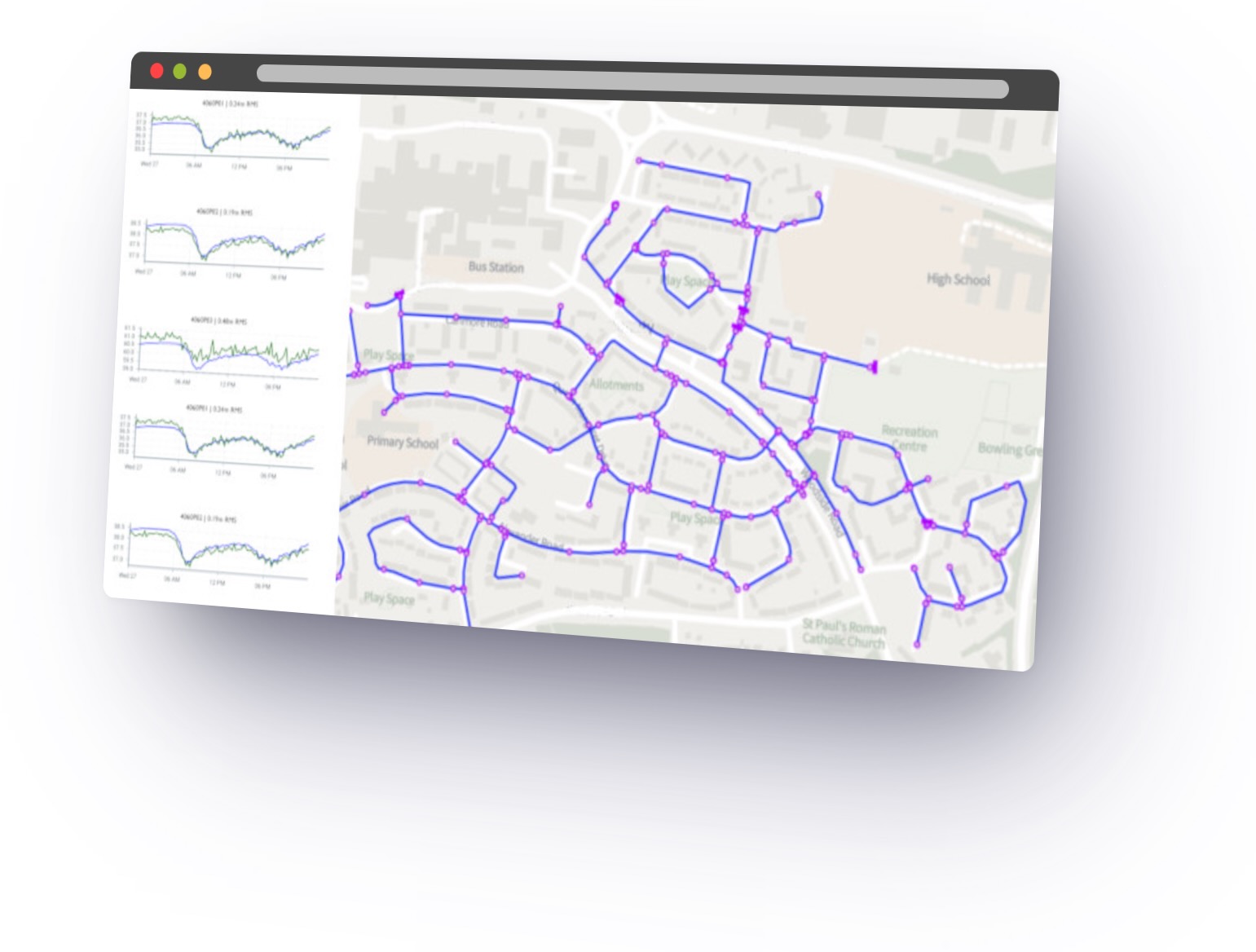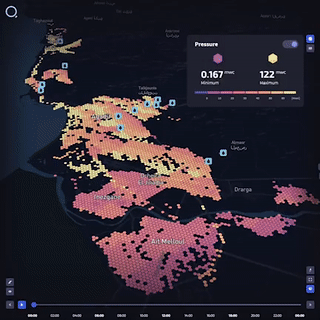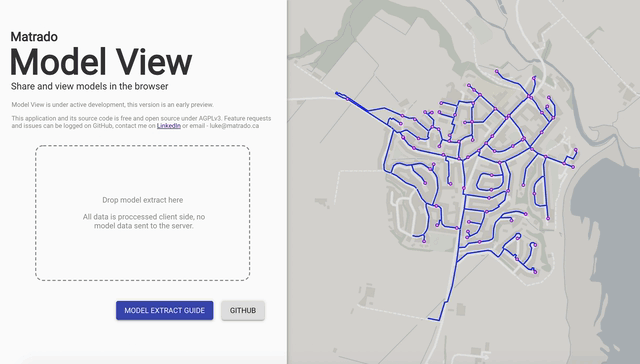Water distribution network modelling, either in the browser or with Node. Uses OWA-EPANET v2.2 toolkit compiled to Javascript.
Note: All version before 1.0.0 should be considered beta with potential breaking changes between releases, use in production with caution.
Install • Usage • About • Examples • Featured Apps • Build • API • License
Use npm to install the latest stable version
$ npm install epanet-js
Run this example on CodeSandbox
import {Project, Workspace} from 'epanet-js'
import fs from 'fs'
// Read an existing inp file from your local disk
const net1 = fs.readFileSync('net1.inp')
// Initialise a new Workspace and Project object
const ws = new Workspace();
const model = new Project(ws);
// Write a copy of the inp file to the virtual workspace
ws.writeFile('net1.inp', net1);
// Runs toolkit methods: EN_open, EN_solveH & EN_close
model.open('net1.inp', 'report.rpt', 'out.bin');
model.solveH()
model.close()More Examples
- Step through the hydraulic simulation
- New model builder API
- Fire Flow Analysis using React
- Float valves using React Code (WIP) - Demo
Engineers use hydraulic modelling software to simulate water networks. A model will represent a network consisting of pipes, pumps, valves and storage tanks. The modelling software tracks the flow of water in each pipe, the pressure at each node, the height of water in each tank throughout the network during a multi-period simulation.
EPANET is an industry-standard program, initially developed by the USEPA, to simulate water distribution networks, its source code was released in the public domain. An open-source fork by the Open Water Analytics (OWA) community maintains and extends its original capabilities. Read more about EPANET on Wikipedia and the OWA community on their website.
The EPANET Toolkit is an API written in C that allows developers to embed the EPANET's engine in their own applications.
Epanet-js is a full port of version 2.2 OWA-EPANET Toolkit in Typescript, providing access to all 122 functions within the toolkit.
The JavaScript library is for engineers, developers and academics to run and share hydraulic analyses or create custom front end or server-side applications.
Reaching version 1.0.0 is the current focus, the first non-beta version will have API stability, full test coverage and have mirrored functions of each method in the EPANET Toolkit.
See the remaining task on the Version 1.0.0 Project.
EPANET 2.3 is currently under development, you can access the latest version of the toolkit within epanet-js by setting an override in your package.json.
Versions of the epanet-engine compile against the dev branch of owa-epanet are tagged as next, find the latest version in npm.
"overrides": {
"epanet-js": {
"@model-create/epanet-engine": "0.6.4-beta.0"
}
}
Qatium is an open and collaborative water management platform, allowing users to run operational scenarios and near-real time simulations using their hydraulic models in the browser.
With an intuitive interface, Qatium provides access to operational hydraulic modelling to those focused on running a water distribution network.
Website: Qatium
Investigate the impact of shutdowns within a water network. Select a pipe, find the isolation valves, the customers impacted, and any alternative supplies, all with one click.
Epanet-js is used to confirm the impact on the network and ensuring alternative supplies are adequate.
Only key information is displayed. Is there low or high pressure, and are there water quality issues to be aware of, such as velocity increases or flow reversals.
Website: Watermain Shutdown
Source Code: GitHub
Extract subsections of your InfoWorks WS Pro models and run them in your browser. As you make calibration changes such as modifying roughness or restriction valves the application runs an epanet model and compares the simulated results to those observered in the field.
Website: Model Calibrate
Source Code: GitHub
Display models created in EPANET directly in the browser. No data leaves your computer; all data rendered and processed locally using the epanet-js library.
Website: Model View
Source Code: GitHub
epanet-js is split into two packages, the epanet-engine package which wraps the original C code in C++ and compiles it to JavaScript using Emscripten. And epanet-js is a TypeScript library which wraps over the generated module from Emscripten and manages memory allocation, error handling and returning of varaible.
Building epanet-engine
The first command yarn run build:dockerimage creates a docker container of Emscripten and the compiled OWA-EPANET source code, you can then run yarn run build to compile the C++ wrapper into Javascript.
cd packages/epanet-engine
yarn run build:dockerimage
yarn run buildBuilding epanet-js
You must first build epanet-engine before you can lint, test or build epanet-js.
cd packages/epanet-js
yarn install
yarn run lint
yarn run test
yarn run buildepanet-js contains two classes, Workspace & Project. A Workspace represents a virtual file system where you can store and read files that are consumed by the tool kit, such as INP Files or generated by it, such as RPT files or OUT files.
A Project is a single instance of the EN_Project wrapper object and a singleton with all 122 toolkit methods attached. A full list of all methods can be found on the epanet-js website. All method names have been converted to camelCase to keep with javascript convention.
Create a Project object by instancing the Project class with a Workspace object.
import { Project, Workspace } from `epanet-js`
const ws = new Workspace()
const model = new Project(ws)Both epanet-js and @model-create/epanet-engine are MIT licenced.
The hydraulic engine used within the epanet-js library is OWA-EPANET 2.2, which is MIT licenced, with contributions by the following authors.







